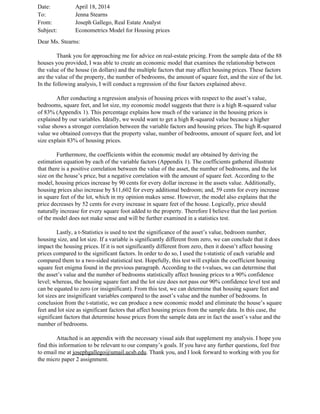
Econometric Model Analyzes Factors Impacting Housing Prices
- 1. Date: April 18, 2014 To: Jenna Stearns From: Joseph Gallego, Real Estate Analyst Subject: Econometrics Model for Housing prices Dear Ms. Stearns: Thank you for approaching me for advice on realestate pricing. From the sample data of the 88 houses you provided, I was able to create an economic model that examines the relationship between the value of the house (in dollars) and the multiple factors that may affect housing prices. These factors are the value of the property, the number of bedrooms, the amount of square feet, and the size of the lot. In the following analysis, I will conduct a regression of the four factors explained above. After conducting a regression analysis of housing prices with respect to the asset’s value, bedrooms, square feet, and lot size, my economic model suggests that there is a high Rsquared value of 83% (Appendix 1). This percentage explains how much of the variance in the housing prices is explained by our variables. Ideally, we would want to get a high Rsquared value because a higher value shows a stronger correlation between the variable factors and housing prices. The high Rsquared value we obtained conveys that the property value, number of bedrooms, amount of square feet, and lot size explain 83% of housing prices. Furthermore, the coefficients within the economic model are obtained by deriving the estimation equation by each of the variable factors (Appendix 1). The coefficients gathered illustrate that there is a positive correlation between the value of the asset, the number of bedrooms, and the lot size on the house’s price, but a negative correlation with the amount of square feet. According to the model, housing prices increase by 90 cents for every dollar increase in the assets value. Additionally, housing prices also increase by $11,602 for every additional bedroom; and, 59 cents for every increase in square feet of the lot, which in my opinion makes sense. However, the model also explains that the price decreases by 52 cents for every increase in square feet of the house. Logically, price should naturally increase for every square foot added to the property. Therefore I believe that the last portion of the model does not make sense and will be further examined in a statistics test. Lastly, a tStatistics is used to test the significance of the asset’s value, bedroom number, housing size, and lot size. If a variable is significantly different from zero, we can conclude that it does impact the housing prices. If it is not significantly different from zero, then it doesn’t affect housing prices compared to the significant factors. In order to do so, I used the tstatistic of each variable and compared them to a twosided statistical test. Hopefully, this test will explain the coefficient housing square feet enigma found in the previous paragraph. According to the tvalues, we can determine that the asset’s value and the number of bedrooms statistically affect housing prices to a 90% confidence level; whereas, the housing square feet and the lot size does not pass our 90% confidence level test and can be equated to zero (or insignificant). From this test, we can determine that housing square feet and lot sizes are insignificant variables compared to the asset’s value and the number of bedrooms. In conclusion from the tstatistic, we can produce a new economic model and eliminate the house’s square feet and lot size as significant factors that affect housing prices from the sample data. In this case, the significant factors that determine house prices from the sample data are in fact the asset’s value and the number of bedrooms. Attached is an appendix with the necessary visual aids that supplement my analysis. I hope you find this information to be relevant to our company’s goals. If you have any further questions, feel free to email me at josephgallego@umail.ucsb.edu. Thank you, and I look forward to working with you for the micro paper 2 assignment.
- 2. Date: April 18, 2014 To: Jenna Stearns From: Joseph Gallego, Real Estate Analyst Subject: Econometrics Model for Housing prices Appendix: Model: Comparison of housing price with value of the asset, number of bedrooms, space in square feet and lot size. Regression on EViews: ls hprice c hassess bdrms sqrft lotsize Estimation Equation: ========================= HPRICE = C(1) + C(2)*HASSESS + C(3)*BDRMS + C(4)*SQRFT + C(5)*LOTSIZE Substituted Coefficients: ========================= HPRICE = 38887.0154265 + 0.908299068323*HASSESS + 11602.4896345*BDRMS 0.517459901499*SQRFT + 0.586729214593*LOTSIZE 1.645 90% two tailed 1.960 95% two tailed 2.576 99% two tailed